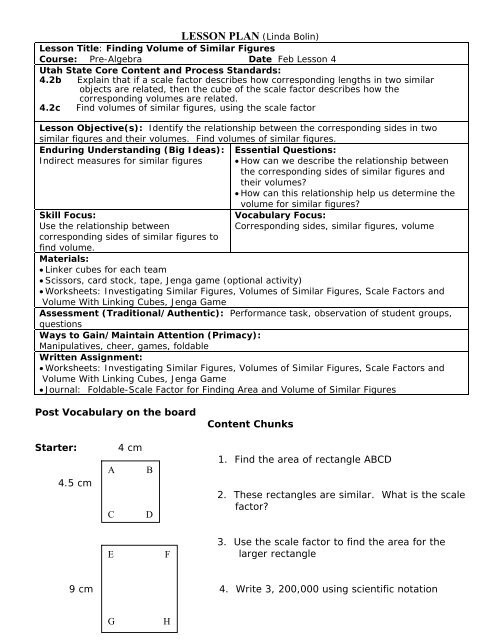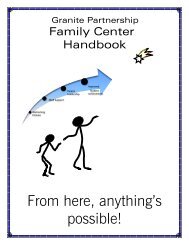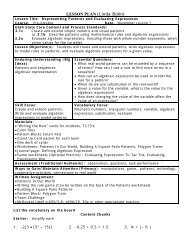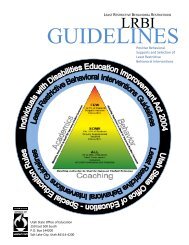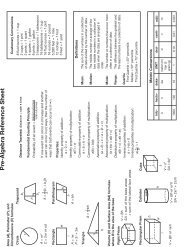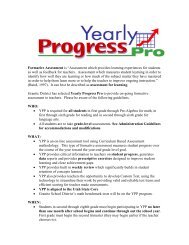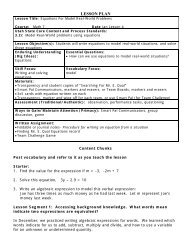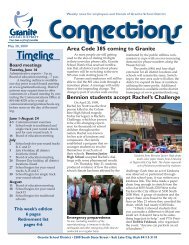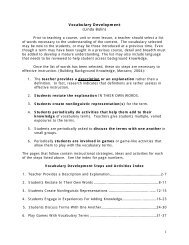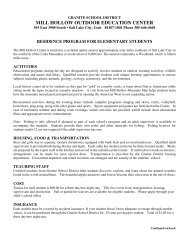Volume of Similar Figures - Granite School District
Volume of Similar Figures - Granite School District
Volume of Similar Figures - Granite School District
You also want an ePaper? Increase the reach of your titles
YUMPU automatically turns print PDFs into web optimized ePapers that Google loves.
LESSON PLAN (Linda Bolin)<br />
Lesson Title: Finding <strong>Volume</strong> <strong>of</strong> <strong>Similar</strong> <strong>Figures</strong><br />
Course: Pre-Algebra Date Feb Lesson 4<br />
Utah State Core Content and Process Standards:<br />
4.2b Explain that if a scale factor describes how corresponding lengths in two similar<br />
objects are related, then the cube <strong>of</strong> the scale factor describes how the<br />
corresponding volumes are related.<br />
4.2c Find volumes <strong>of</strong> similar figures, using the scale factor<br />
Lesson Objective(s): Identify the relationship between the corresponding sides in two<br />
similar figures and their volumes. Find volumes <strong>of</strong> similar figures.<br />
Enduring Understanding (Big Ideas): Essential Questions:<br />
Indirect measures for similar figures • How can we describe the relationship between<br />
the corresponding sides <strong>of</strong> similar figures and<br />
their volumes?<br />
• How can this relationship help us determine the<br />
Skill Focus:<br />
Use the relationship between<br />
corresponding sides <strong>of</strong> similar figures to<br />
find volume.<br />
volume for similar figures?<br />
Vocabulary Focus:<br />
Corresponding sides, similar figures, volume<br />
Materials:<br />
• Linker cubes for each team<br />
• Scissors, card stock, tape, Jenga game (optional activity)<br />
• Worksheets: Investigating <strong>Similar</strong> <strong>Figures</strong>, <strong>Volume</strong>s <strong>of</strong> <strong>Similar</strong> <strong>Figures</strong>, Scale Factors and<br />
<strong>Volume</strong> With Linking Cubes, Jenga Game<br />
Assessment (Traditional/Authentic): Performance task, observation <strong>of</strong> student groups,<br />
questions<br />
Ways to Gain/Maintain Attention (Primacy):<br />
Manipulatives, cheer, games, foldable<br />
Written Assignment:<br />
• Worksheets: Investigating <strong>Similar</strong> <strong>Figures</strong>, <strong>Volume</strong>s <strong>of</strong> <strong>Similar</strong> <strong>Figures</strong>, Scale Factors and<br />
<strong>Volume</strong> With Linking Cubes, Jenga Game<br />
• Journal: Foldable-Scale Factor for Finding Area and <strong>Volume</strong> <strong>of</strong> <strong>Similar</strong> <strong>Figures</strong><br />
Post Vocabulary on the board<br />
Content Chunks<br />
Starter:<br />
4.5 cm<br />
A<br />
C<br />
4 cm<br />
B<br />
D<br />
1. Find the area <strong>of</strong> rectangle ABCD<br />
2. These rectangles are similar. What is the scale<br />
factor?<br />
E<br />
F<br />
3. Use the scale factor to find the area for the<br />
larger rectangle<br />
9 cm 4. Write 3, 200,000 using scientific notation<br />
G<br />
H
Lesson Segment 1: How can we describe the relationship between the<br />
corresponding sides <strong>of</strong> similar figures and their areas?<br />
Give each team <strong>of</strong> students 100 linking cubes. They will be building similar prisms and<br />
comparing the ratio <strong>of</strong> corresponding sides to the ratio <strong>of</strong> the volumes. Work with<br />
them to build prisms as they complete the “Investigating <strong>Similar</strong> <strong>Figures</strong>, Scale Factors<br />
and <strong>Volume</strong> With Linking Cubes” investigation worksheet. If they have difficulty<br />
building a rectangular prism, remind them to first build the base by forming lw, and<br />
then stack the number <strong>of</strong> layers for h.<br />
As they work together in small groups, ask them to rotate roles: Builder (handles the<br />
cubes), Coach (tells builder how it should look and suggest ideas for building),<br />
Draftsman (reminds all to sketch the prisms helping each <strong>of</strong> them with the drawing),<br />
Encourager (makes sure there are no put-downs and that each person is taking a turn<br />
with the roles). Have students build and sketch, and discuss the answers to the<br />
questions as a class.<br />
Predicting and testing the hypotheses: Remind students that in the last lesson,<br />
when finding area (or the number <strong>of</strong> squares needed to cover a similar figure), they<br />
used the scale factor squared. Ask students to predict what might happen with the<br />
scale factor when finding volumes <strong>of</strong> similar figures. Have them look for a pattern that<br />
relates the scale factor to the number <strong>of</strong> cube units in each prism. Make sure student<br />
focus on the relationship between the scale factor and the new volume. They should<br />
begin to see that the units <strong>of</strong> volume in the larger figure are always the original volume<br />
multiplied by the cube <strong>of</strong> the scale factor. When they write the ratio for each make this<br />
explicit: The volume <strong>of</strong> the larger figure is the cube <strong>of</strong> the scale factor multiplied by<br />
the volume <strong>of</strong> the smaller figure. Help them make the connection between volume<br />
being measured in cubed units and the scale factor being cubed when finding the<br />
volume <strong>of</strong> the larger prism.<br />
Lesson Segment 2: How can the relationship between volumes <strong>of</strong> similar<br />
figures help us find missing areas?<br />
Teach the students the following cheer. Have them compare this cheer to the cheer for<br />
area from the last lesson. How are the procedures the same? Different?<br />
<strong>Similar</strong> figures? I don’t cry.<br />
I can find volume if I try.<br />
Cube the scale factor and multiply<br />
By the smaller volume! My oh My!<br />
<strong>Similar</strong> figures? I’m not scared!<br />
I’ll find area if I’m dared.<br />
Multiply the scale factor squared<br />
By the smaller area-I’m prepared!
Play Lie Detector again for completing the worksheet, <strong>Volume</strong> <strong>of</strong> <strong>Similar</strong> <strong>Figures</strong>.<br />
Materials: Give each small group a Smart Pal with blank paper or large team board and<br />
marker<br />
Procedure: Divide the class into two teams, A and B. Team members work together to<br />
complete one assigned part <strong>of</strong> the worksheet. Give students a little time to check with<br />
team members and to work the part <strong>of</strong> the worksheet correctly. The team should then<br />
decide if they are going to tell a lie or tell the truth. If they choose to tell the truth, a<br />
scribe writes the responses to the worksheet correctly on the Smart Pal or Team Board.<br />
If they decide to tell a lie, the scribe writes part <strong>of</strong> their response incorrectly on the<br />
Smart Pal or team board. Teacher selects one person from team A to be The<br />
Presenter. The Presenter stands in the front <strong>of</strong> the room shows the team board and<br />
explains what was done (either telling the truth, or telling a lie about the problem).<br />
The class is given a little time to discuss the response in small groups. The Presenter<br />
then chooses one person from Team B to be the Lie Detector and to tell whether they<br />
believe the explanation was truth or lie. If The Lie Detector thinks the explanation was<br />
a lie, he/she has to explain where the lie occurred and correct it. If the Lie Detector is<br />
correct, Team B gets a point. If not, The Presenter tells whether their explanation was<br />
the truth or a lie. If it was a lie, The Presenter tells why. The game proceeds with<br />
each team taking a turn to be Presenter and Lie Detector.<br />
Journal:<br />
Students should make the foldable and fill in the blanks to show each step.<br />
Application review <strong>of</strong> the affect <strong>of</strong> scale factor on length, area, and volume.<br />
Have student play Jenga as described on the attached worksheet.
Investigating <strong>Similar</strong><br />
<strong>Figures</strong>, Scale Factors and<br />
<strong>Volume</strong> With Linking Cubes<br />
Name____________________________<br />
Date _______<br />
Use linking cubes to build the two<br />
similar prisms for each problem. Count<br />
the volume (cubes) for each. Fill in the blanks.<br />
1. Build a cube with side length <strong>of</strong> 1. Sketch it here.<br />
Build a similar figure using a scale factor <strong>of</strong> 2. Sketch it here.<br />
<strong>Volume</strong> <strong>of</strong> smaller cube _____. <strong>Volume</strong> <strong>of</strong> larger cube _____.<br />
What is the value <strong>of</strong> the scale factor³?_____.<br />
What is the ratio <strong>of</strong> the larger cube’s volume to the smaller cube’s volume ______.<br />
2. Build a cube with side length <strong>of</strong> 2. Sketch it here.<br />
Build a similar figure using a scale factor <strong>of</strong> 2. Sketch it here.<br />
<strong>Volume</strong> <strong>of</strong> smaller cube _____. <strong>Volume</strong> <strong>of</strong> larger cube _____.<br />
What is the value <strong>of</strong> the scale factor³?_____.<br />
What is the ratio <strong>of</strong> the larger cube’s volume to the smaller cube’s volume ______.<br />
3. Build a prism with dimensions l =1, w =2, h =2. Sketch it here.<br />
Build a similar figure using a scale factor <strong>of</strong> 2. Sketch it here.<br />
<strong>Volume</strong> <strong>of</strong> smaller prism _____. <strong>Volume</strong> <strong>of</strong> larger prism _____.<br />
What is the value <strong>of</strong> the scale factor³?_____.<br />
What is the ratio <strong>of</strong> the larger prism’s volume to the smaller prism’s volume ______.
4. Build a cube with side length <strong>of</strong> 1.<br />
Build a similar figure using a scale factor <strong>of</strong> 3. Sketch it here.<br />
<strong>Volume</strong> <strong>of</strong> smaller cube _____. <strong>Volume</strong> <strong>of</strong> larger cube _____.<br />
What is the value <strong>of</strong> the scale factor³?_____.<br />
What is the ratio <strong>of</strong> the larger cube’s volume to the smaller cube’s volume ______.<br />
5. Build a cube with side length <strong>of</strong> 2. Sketch it here.<br />
Build a similar figure using a scale factor <strong>of</strong> 3. Sketch it here.<br />
<strong>Volume</strong> <strong>of</strong> smaller cube _____. <strong>Volume</strong> <strong>of</strong> larger cube _____.<br />
What is the value <strong>of</strong> the scale factor³?_____.<br />
What is the ratio <strong>of</strong> the larger cube’s volume to the smaller cube’s volume ______.<br />
6. Build a prism with dimensions l =1, w =2, h =2. Sketch it here.<br />
Build a similar figure using a scale factor <strong>of</strong> 3. Sketch it here.<br />
<strong>Volume</strong> <strong>of</strong> smaller prism _____. <strong>Volume</strong> <strong>of</strong> larger prism _____.<br />
What is the value <strong>of</strong> the scale factor³?_____.<br />
What is the ratio <strong>of</strong> the larger prism’s volume to the smaller prism’s volume ______.<br />
7. How does the scale factor compare to the ratio <strong>of</strong> the volumes?<br />
8. If you build two similar cubes with a scale factor <strong>of</strong> 4, what would you expect the<br />
ratio <strong>of</strong> their volumes to be? Explain your answer.
<strong>Volume</strong>s <strong>of</strong> <strong>Similar</strong> <strong>Figures</strong><br />
Name _____________________<br />
Date____<br />
Each set <strong>of</strong> three figures below are similar within the set.<br />
1. Fill in the blanks for the missing measurements in prism B and prism C. What is the<br />
scale factor for prism B ____ ? For prism C_____?<br />
A) B) C)<br />
4 8 ___?<br />
2<br />
3 4<br />
___? 6<br />
9<br />
2. Find the volume for prism A, and then find the volume for Prism B and for C using<br />
the scale factor for each.<br />
A) B) C)<br />
3. Fill in the blanks for the missing measurements prism E and prism F. What is the<br />
scale factor for prism E ____ ? For prism F____?<br />
D) E) F)<br />
2<br />
2<br />
2 6 ___?<br />
___?<br />
6 10<br />
10<br />
4. Find the volume for prism D, and then find the volume for Prism E and for F using<br />
the scale factor for each.<br />
D) E) F)
5. Fill in the blanks for the missing measurements for cylinder H and cylinder I. What<br />
is the scale factor for cylinder H ____ ? For cylinder I____?<br />
G) H) I)<br />
4<br />
2 16 ___?<br />
___?<br />
10<br />
6. Find the volume for prism G, and then find the volume for Prism H and for I using<br />
the scale factor for each.<br />
G) H) I)<br />
K) Explain the relationship between the scale factor and the volume <strong>of</strong> two similar<br />
figures.<br />
L) Complete the table below for the given dimensions and scale factors <strong>of</strong> the similar<br />
figures described.<br />
Dimensions <strong>of</strong> a<br />
smaller figure<br />
<strong>Volume</strong> <strong>of</strong> the<br />
smaller figure<br />
Scale factor<br />
for a larger<br />
figure<br />
Rectangular prism:<br />
l = 3, w = 5, h = 4 4<br />
Cube:<br />
S = 5 3<br />
Cylinder:<br />
r = 3, h = 10 2<br />
Rectangular prism:<br />
l = 8, w = 2.5, h = 4 5<br />
Cube:<br />
S = 4 2<br />
Cylinder:<br />
r = 6, h = 5 3<br />
<strong>Volume</strong> for larger<br />
figure
Scale Factor For<br />
Finding Area<br />
Of <strong>Similar</strong> <strong>Figures</strong><br />
Scale Factor For<br />
Finding <strong>Volume</strong><br />
Of <strong>Similar</strong> <strong>Figures</strong>
5<br />
?<br />
2<br />
4<br />
To find the area <strong>of</strong> the larger figure, follow these<br />
steps:<br />
1. Find the scale factor like this _____________<br />
2. Square the scale factor like this ___________<br />
3. Find the area <strong>of</strong> the smaller figure like this<br />
____________________<br />
4 Multiply the squared scale factor by the small<br />
area like this ________________________<br />
4<br />
2<br />
?<br />
3<br />
?<br />
6<br />
To find the volume <strong>of</strong> the larger figure, follow<br />
these steps:<br />
1. Find the scale factor like this _____________<br />
2. Cube the scale factor like this ___________<br />
3. Find the volume <strong>of</strong> the smaller figure like this<br />
____________________<br />
4 Multiply the cubed scale factor by the small<br />
volume like this ____________________
TEAM JENGA HOW MANY JENGAS CAN YOU BUILD?<br />
Name____________________<br />
You will need: scissors, tape, ruler, a small piece <strong>of</strong> card stock and a large piece<br />
<strong>of</strong> card stock or construction paper.<br />
1. Sketch your Jenga block (also known as a rectangular prism.)<br />
2. Using the small paper, make a net for<br />
the Jenga block (wrapping all the<br />
surfaces). Sketch the net for the Jenga.<br />
3. How many lateral faces are there? ____ How many bases are there? ____<br />
4. Measure the length, width and height <strong>of</strong> your JENGA (in centimeters)<br />
Length =_______ Width = ________ Height = _________<br />
5. Find the volume <strong>of</strong> your Jenga. (see class reference sheet for formula)<br />
6. Find the surface area <strong>of</strong> your Jenga block (see reference sheet)<br />
7. If the Jenga is enlarged using a scale factor <strong>of</strong> 2, what will the dimensions<br />
<strong>of</strong> the larger Jenga be? Length = ________ Width = ________<br />
Height = _________<br />
8. If the Jenga is enlarged using a scale factor <strong>of</strong> 2, what will the surface<br />
area <strong>of</strong> the larger Jenga be?<br />
9. Using the large piece <strong>of</strong> paper, make a net <strong>of</strong> the larger Jenga.
10. When everyone on your team has finished to # 9, write the time here.<br />
__________. Call your teacher over to initial that all have finished to this<br />
point. _____________. (Teacher initials)<br />
11. As a team it is your job to build from card stock as many <strong>of</strong> the enlarger<br />
Jengas as possible in 30 minutes. Work together as a team with everyone<br />
contributing to the building.<br />
12. How many congruent Jengas did your team build? _____ (If your Jengas<br />
are not congruent, they will not stack and slide well for playing Jenga.)<br />
Now play Jenga:<br />
As a team, build the highest tower you can build without it toppling over. You<br />
get three tries. Record your heights (levels) for your three tries here:<br />
Round 1____, Round 2____, Round 3 ____<br />
Next, rebuild the next highest tower. Take turns sliding pieces out <strong>of</strong> the<br />
Jenga without toppling the tower. You get 1 point for each block pulled out<br />
without toppling the tower. You do not get a point for the block that topples<br />
the tower.<br />
Scoring: 1 point for each level in the highest tower + 1 point for each block<br />
removed without toppling the tower.<br />
SCORE HERE:<br />
13. How did each person on your team contribute to the team’s success in the<br />
building?<br />
14. What did you learn from this team project?


